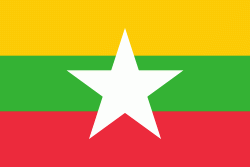Flag of Myanmar
The State Flag of the Republic of the Union of Myanmar was adopted on 21 October 2010.
The State flag described in the 2008 Constitution of the Republic of the Union of Myanmar was adopted by enacting the 2010 Union Flag Law and the repealing of the 1974 State Flag Law on 21 October 2010. It was hoisted for the first time at 3:00 p.m. local time on 21 October 2010. Orders were also handed out to ensure all old flags were burned.
Unlike the previous 1974 State Flag Law, the 2010 Union Flag Law includes the definition of the flag. The current flag is a horizontal tricolour flag of yellow, green, and red charged with a five-pointed white star in the centre of the field. The background is a yellow, green, and red tricolor meant to honour the tricolours used during the independence struggle. The yellow represents unity, conformity, wisdom, happiness, and unity of all national races amicably. The green symbolises fertility, conformity, fairness, and being a peaceful, pleasant, and green nation. The red represents bravery and decisiveness. The white star stands for purity, honesty, fullness of compassion, and power.
The State flag described in the 2008 Constitution of the Republic of the Union of Myanmar was adopted by enacting the 2010 Union Flag Law and the repealing of the 1974 State Flag Law on 21 October 2010. It was hoisted for the first time at 3:00 p.m. local time on 21 October 2010. Orders were also handed out to ensure all old flags were burned.
Unlike the previous 1974 State Flag Law, the 2010 Union Flag Law includes the definition of the flag. The current flag is a horizontal tricolour flag of yellow, green, and red charged with a five-pointed white star in the centre of the field. The background is a yellow, green, and red tricolor meant to honour the tricolours used during the independence struggle. The yellow represents unity, conformity, wisdom, happiness, and unity of all national races amicably. The green symbolises fertility, conformity, fairness, and being a peaceful, pleasant, and green nation. The red represents bravery and decisiveness. The white star stands for purity, honesty, fullness of compassion, and power.
National flag
Country - Burma
Warning: getimagesize(/Image/Map/MP1327865.gif): failed to open stream: No such file or directory in /home/mapnlee7/public_html/MAPNALL/article.php on line 532
 |
 |
Early civilisations in the area included the Tibeto-Burman-speaking Pyu city-states in Upper Myanmar and the Mon kingdoms in Lower Myanmar. In the 9th century, the Bamar people entered the upper Irrawaddy valley, and following the establishment of the Pagan Kingdom in the 1050s, the Burmese language, culture, and Theravada Buddhism slowly became dominant in the country. The Pagan Kingdom fell to Mongol invasions, and several warring states emerged. In the 16th century, reunified by the Taungoo dynasty, the country became the largest empire in the history of Southeast Asia for a short period.
